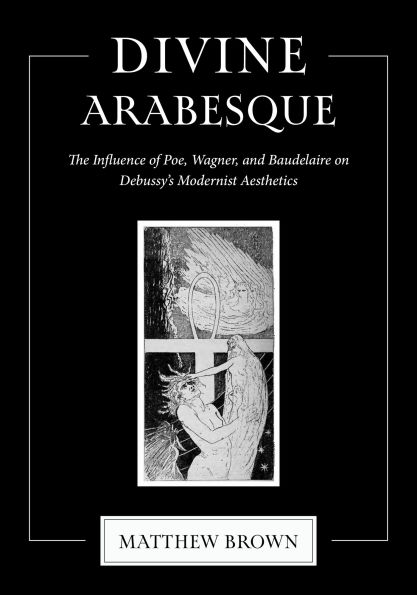Divine Arabesque: The Influence of Poe, Wagner, and Baudelaire on Debussy's Modernist Aesthetics
The arabesque, a crucial component of nineteenth-century aesthetics characterized by recurring patterns of interlocking geometric and floral ornamentation, was found in a wide range of forms of artistic expression and played a pivotal role in the music of Claude Debussy. Divine Arabesque explores the arabesque in Debussy's music and reveals its profound influence on his musical repertoire and on the works of other Symbolist artists and writers.
Taking as his starting point a discussion of the short manifesto Debussy published in "La Revue blanche" in 1901, author Matthew Brown embarks on a thorough and comprehensive analysis of Debussy's works across all phases of his career and genres—from his early songs and piano pieces to mature orchestral compositions and late works. Along the way, Brown unveils the intertextual connections between Debussy's compositions and the works of such Symbolist artists as Edgar Allen Poe, Richard Wagner, Charles Baudelaire, Stéphane Mellarmé, Vaslav Nijinsky, and others.
Featuring a rich collection of music examples and illustrations, Divine Arabesque sheds new light on the full range of Debussy's musical output and establishes his critical role in ushering in the age of Modernism.
1147254602
Taking as his starting point a discussion of the short manifesto Debussy published in "La Revue blanche" in 1901, author Matthew Brown embarks on a thorough and comprehensive analysis of Debussy's works across all phases of his career and genres—from his early songs and piano pieces to mature orchestral compositions and late works. Along the way, Brown unveils the intertextual connections between Debussy's compositions and the works of such Symbolist artists as Edgar Allen Poe, Richard Wagner, Charles Baudelaire, Stéphane Mellarmé, Vaslav Nijinsky, and others.
Featuring a rich collection of music examples and illustrations, Divine Arabesque sheds new light on the full range of Debussy's musical output and establishes his critical role in ushering in the age of Modernism.
Divine Arabesque: The Influence of Poe, Wagner, and Baudelaire on Debussy's Modernist Aesthetics
The arabesque, a crucial component of nineteenth-century aesthetics characterized by recurring patterns of interlocking geometric and floral ornamentation, was found in a wide range of forms of artistic expression and played a pivotal role in the music of Claude Debussy. Divine Arabesque explores the arabesque in Debussy's music and reveals its profound influence on his musical repertoire and on the works of other Symbolist artists and writers.
Taking as his starting point a discussion of the short manifesto Debussy published in "La Revue blanche" in 1901, author Matthew Brown embarks on a thorough and comprehensive analysis of Debussy's works across all phases of his career and genres—from his early songs and piano pieces to mature orchestral compositions and late works. Along the way, Brown unveils the intertextual connections between Debussy's compositions and the works of such Symbolist artists as Edgar Allen Poe, Richard Wagner, Charles Baudelaire, Stéphane Mellarmé, Vaslav Nijinsky, and others.
Featuring a rich collection of music examples and illustrations, Divine Arabesque sheds new light on the full range of Debussy's musical output and establishes his critical role in ushering in the age of Modernism.
Taking as his starting point a discussion of the short manifesto Debussy published in "La Revue blanche" in 1901, author Matthew Brown embarks on a thorough and comprehensive analysis of Debussy's works across all phases of his career and genres—from his early songs and piano pieces to mature orchestral compositions and late works. Along the way, Brown unveils the intertextual connections between Debussy's compositions and the works of such Symbolist artists as Edgar Allen Poe, Richard Wagner, Charles Baudelaire, Stéphane Mellarmé, Vaslav Nijinsky, and others.
Featuring a rich collection of music examples and illustrations, Divine Arabesque sheds new light on the full range of Debussy's musical output and establishes his critical role in ushering in the age of Modernism.
150.0
Pre Order
5
1

Divine Arabesque: The Influence of Poe, Wagner, and Baudelaire on Debussy's Modernist Aesthetics
648
Divine Arabesque: The Influence of Poe, Wagner, and Baudelaire on Debussy's Modernist Aesthetics
648
150.0
Pre Order

Product Details
| ISBN-13: | 9780253074553 |
|---|---|
| Publisher: | Indiana University Press |
| Publication date: | 03/31/2026 |
| Pages: | 648 |
| Product dimensions: | 8.50(w) x 11.00(h) x 0.00(d) |
About the Author
From the B&N Reads Blog
